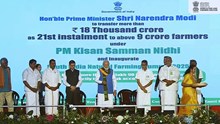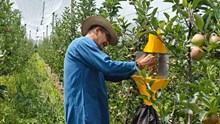
Jackfruit, often regarded as a backyard fruit, has long been an integral part of traditional rural diets in India. Its sweet, nutritious flakes and hardy nature make it a dependable fruit tree for homesteads. Yet, despite its potential, jackfruit cultivation remained largely unorganized, with limited commercial utilization. Recognizing this untapped potential, ICAR-IIHR took a pioneering step to rediscover the value of this traditional fruit.
Beginning in 2014, the institute conducted extensive surveys in the long-established jackfruit belts of Southern Karnataka, particularly in districts like Tumkur. From 128 jackfruit samples identified, researchers narrowed the selection down to 42 based on characteristics such as flake colour, texture, fruit size, and nutritional content. From this pool, two superior varieties—Siddu and Shankara—were finalized. Both feature distinctly coppery red-coloured flakes and are rich in nutrients.

Siddu and Shankara: A Nutritional Treasure
Siddu jackfruit originates from a 35-year-old tree in Tumkur. It is distinguished by its intense coppery-red flakes that are firm, sweet, and visually appealing. Each fruit weighs approximately 2.44 kilograms and has 25 to 30 bulbs, ideal for family use. The fruit has good total soluble solids (TSS) of 31 degrees Brix, which shows good sweetness and quality for eating.
Nutritionally, Siddu is a powerhouse. It is high in total carotenoids (4.43 mg/100 g), lycopene (1.12 mg/100 g), vitamin C (6.48 mg/100 g), and phenolics (31.76 mg Gallic acid equivalents/100 g). These phytochemicals are known for their antioxidant activities and are known to enhance immunity. It prevents cell damage and enhances general well-being. The fruit also exhibits considerable antioxidant activity and thus qualifies as a good functional food that contributes towards improved health and nutrition.
Shankara, the second high-end variety, is a selection from a 25-year-old tree, again in Tumkur. It produces fruits of 2 to 5 kilograms each with approximately 60 sweet, crisp, and aromatic flakes. Shankara, similar to Siddu, has a stunning coppery red color and dense nutritional content. It has 5.83 mg of carotenoids and 2.26 mg of lycopene per 100 grams. These are much greater than those contained in white or yellow flaked jackfruit varieties.
Unique Features and Adaptability
The Siddu and Shankara jackfruits are not only attractive in appearance but also possess qualities that make them highly suitable for commercial cultivation. The trees are hardy and can be grown in a variety of tropical and subtropical climates, particularly in regions with moderate rainfall and well-drained soils. These varieties are well-suited for homesteads and small orchards, as well as for larger plantations aimed at commercial markets.
Siddu trees are broadly pyramidal in shape and can yield up to 450 fruits annually. The estimated yield per tree is around 1098 kilograms. This makes it economically viable for farmers. Each fruit contains 25 to 30 thick, sweet flakes weighing about 24.5 grams each. Shankara, on the other hand, provides slightly larger fruits with around 60 flakes, each averaging 18 grams in weight. Both varieties are easy to consume, have minimal fiber, and are favoured by consumers for their unique color and taste.
In terms of market appeal, the coppery red color of these flakes gives them a clear edge, especially in premium fruit markets and health-conscious consumer segments. With increasing awareness about the health advantages of naturally colored fruits, demand for such varieties as Siddu and Shankara is bound to grow.

Commercialization and Farmer Benefits
To make the effort sustainable, ICAR-IIHR came up with a novel commercialization model in 2017. The model ensures that 75 percent of the revenue generated from sapling sales goes to the farmer directly. The institute keeps 25 percent to fund further research and extension. For example, if a sapling is sold for Rs. 150, the farmer gets Rs. 112 and the institute gets Rs. 38.
This revenue-sharing model empowers farmers, preserves biodiversity, and ensures that the genetic wealth of traditional varieties is not lost. More importantly, it transforms farming into a dignified and profitable occupation. In this model, farmers are respected not only as producers, but as guardians of nature and innovation.
Way Forward: Linking Biodiversity to Livelihood and Health
The success of Siddu and Shankara jackfruit is not merely a horticultural success. It is a model of how native biodiversity, when scientifically proven and adequately promoted, can be a source of livelihood, pride, and sustainability for rural communities.
The consumer demand is growing for naturally colorful, nutritious, and chemical-free fruits. These varieties, like Siddu and Shankara hold great market potential — both locally and nationally.These fruits, with their very attractive color and high nutritional content, can also be marketed as functional foods. It is presenting new opportunities in health-conscious and organic markets.
The jackfruit story of Tumkur is a forceful reminder that the solutions to rural poverty, nutritional insecurity, and biodiversity erosion often exist within communities themselves. Farmers can take the lead in shaping Indian agriculture into a resilient and sustainable future with a bit of support, awareness, and a constructive approach.
The Siddu and Shankara jackfruit varieties, developed by ICAR-IIHR, symbolize hope, nutrition, and prosperity. With their vibrant coppery red flakes, these fruits are rich in phytochemicals that support immune health and overall well-being. By adopting these varieties, farmers in suitable regions can enhance their incomes and contribute to India’s nutritional goals. This initiative blends traditional knowledge with scientific innovation, highlighting the potential for sustainable agriculture. The story of these jackfruits exemplifies how nurturing both nature and rural communities can lead to positive change.
















